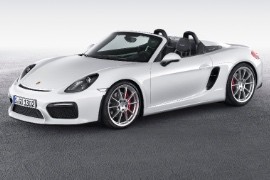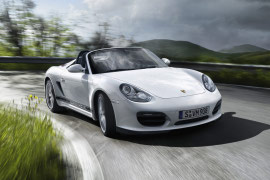PORSCHE Boxster Spyder Models/Series Timeline, Specifications & Photos
First production year: 2009
Engines: Gasoline
Body style: Convertible (spider/spyder, cabrio/cabriolet, drop/open/soft top)
While the previous generation of the Boxster Spyder came at the wrong time, the 2016 was unveiled in 2015 at the New York International Auto Show and enjoyed great success.
Porsche already knew the recipe for creating better sports cars. After all, it built them since the late '40s. So, it followed the same steps as the previous Boxster Spyder launched in 2009 and applied them to the car it introduced in 2015 as a 2016 model year. With the Boxster Spyder, the automaker paid homage to the 917 Spyder from the '60s, but it was more than just a design expression. It was a car built for those who enjoyed running around a track or driving on a winding road as well. Furthermore, the Boxster Spyder extensively used lightweight materials, and an even more powerful engine carried over from its bigger brother, the 911. Last but not least, it had 911 Carrera brakes and a different suspension than the rest of the Boxster range. Even though it was 40 kilos (88 lbs) heavier than its predecessor, the RS60, it was quicker than that.
At the front, the 2016 Boxster Spyder featured a set of bi-xenon headlights carried over from the Boxster S model and had LED parking and daytime running lights. On the lower part of the bumper, the automaker installed a trapezoidal-shaped center air intake flanked by a set of side scoops like those from the rest of the Boxster range. Another significant difference compared to the rest of its stablemates was noticed on the hood, which featured a narrow gap in its forward area, used to release the warm air from a radiator.
Porsche created the Boxster Spyder as a more track-oriented vehicle than the rest of its stablemates. It dropped the ground clearance by 20 mm (0.8-inch) thanks to the modified suspension. Like the 2009 Boxster Spyder, the 2016 model year came with two humps behind the cabin. Customers complained about the previous cover of the 2011 model-year Boxster Spyder, so Porsche took a different approach when it made the 2016 model year. It ditched the power-operated system but most of the other bits and pieces so customers could open it manually and cover the cabin. The only powered system was the latching mechanism above the windshield that secured the roof in place. Also, the humps neatly covered the safety arches behind the seats. At the back of the deck, the automaker installed a deployable wing, which, when it was retracted, looked like a ducktail.
Inside, the Alcantara-covered cabin offered a luxurious and sporty feeling at the same time. The automaker provided customers the opportunity to have the vehicle lighter or heavier. In standard configuration, the car wasn't equipped with an AC unit or a stereo, albeit these were available as a no-cost option. Thanks to the sports seats with integrated headrests, the occupants could sit firmly in their places during high-speed cornering maneuvers. Unlike the 987.2 Spyder, the 981 came with an actual instrument cluster that covered the three-dial panel, where the tachometer took center stage.
Behind the cabin, in a mid-mounted position, the automaker installed a 3.8-liter flat-six carried over from the 911 but detuned to produce 375 PS (370 hp). It was exclusively paired with a six-speed manual that sent the power to the rear wheels via a self-locking differential. Thanks to its power-to-weight ratio, the 2016 Porsche Boxster Spyder could rocket from 0 to 100 kph (0-62 mph) in 4.5 seconds on its way to a top speed of 290 kph.
Porsche put the 987.2 Boxster S on a diet and made the Spyder, a car that was the lightest in the automaker’s lineup, and the car instantly became a collectible vehicle.
Even though the financial crisis started to claim its first victims in the automotive world, Porsche knew that there were some customers who could still pay more for a track-oriented two-seater that could be driven on regular roads. Furthermore, that car shouldn’t cost them too much over a regular, street-oriented vehicle of the same category. That’s why it introduced the Boxster Spyder at the Los Angeles Auto Show in November 2009. While the car used most of the underpinnings from the Boxster S, it also featured a few unique parts that made it distinguishable from its stablemates. Porsche was so keen on getting a lightweight vehicle that even the infotainment unit and the AC were offered as an option. At the same time, the car manufacturer provided standard lower suspension, stiffer damper settings, and a mechanical locking differential that helped the car achieve great performance on track.
There were no significant aesthetic differences between the Boxster S and the Boxster Spyder front fascia, albeit a keen eye for detail could notice them. Porsche installed the same side scoops on both cars, but on the Spyder, these were adorned with satin-gray trims instead of body-colored ones like in the regular Boxster. While it used the same headlights as its stablemates, the LED daytime running lights were removed from the standard equipment list and provided as an option.
The low-slung profile of the car impressed customers with its racy styling. Porsche installed lower windows for the doors as part of the weight-reduction plan. However, the most striking difference was noticed behind the cabin, where the automaker installed an aluminum deck with double bulges that resembled those from the mighty Carrera GT. Furthermore, it placed the third brake light between these two humps. Out back, the automaker removed the automatic retractable wing and its entire mechanism and installed a fixed one. Lower, under the bumper, the Spyder featured the same twin exhaust as the Boxster S. Finally, the automaker installed aluminum doors and the trunk lid to cut weight down. To make the car even more distinguishable from the rest of the Boxster range, Porsche installed unique 19-inch alloy wheels, which were unavailable for any other vehicle in the carmaker’s range.
Inside, the automaker provided the car with leather-wrapped carbon-fiber sports seats. Most of the storage areas and the cup holders were removed, and Porsche added some body-colored parts instead of those. Furthermore, there were no pockets in the door cards, and the door handles were replaced with red pull-straps like in a genuine race car. Another weight-saving solution was to remove the cover for the instrument cluster so the three dials were left out in the open.
The Boxster Spyder, also known as the RS60, was 80 kg (176 lbs) lighter than the Boxster S. Its almost perfect 50/50 weight distribution made it an excellent track vehicle while still comfortable for open roads. Its 3.4-liter, direct-fuel injected engine was carried over from the Boxster S but went through some modifications to provide ten more ponies than that. Customers could get the vehicle with a six-speed manual or Porsche’s seven-speed automatic (dual-clutch) PDK. Furthermore, carbon-ceramic brakes and the Chrono package were available as well.

